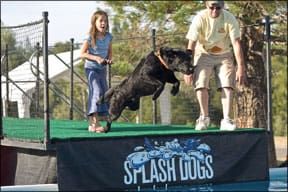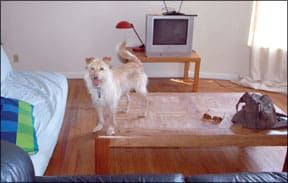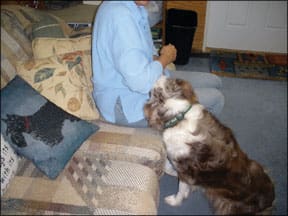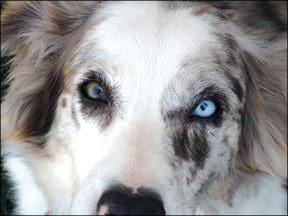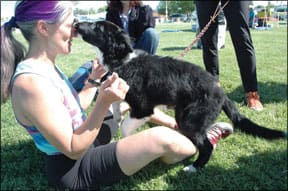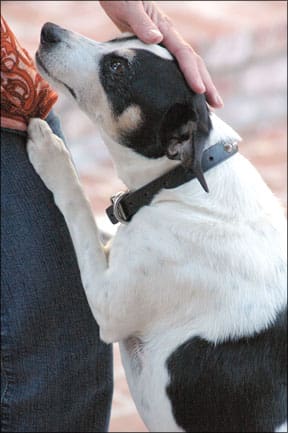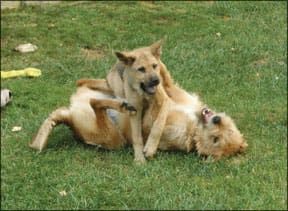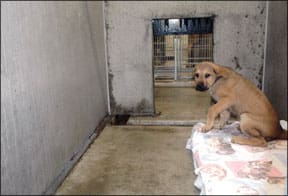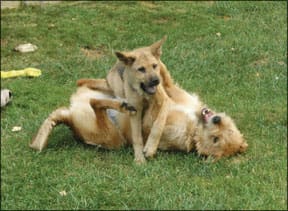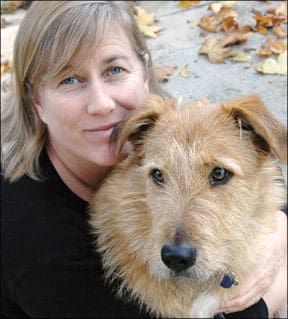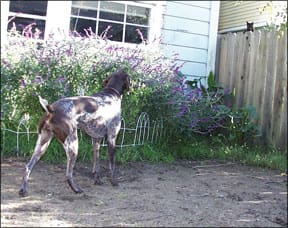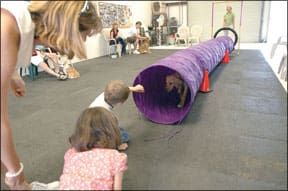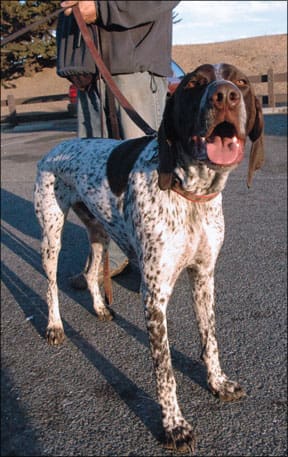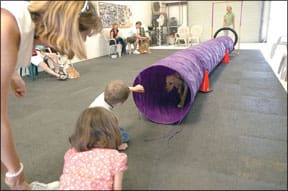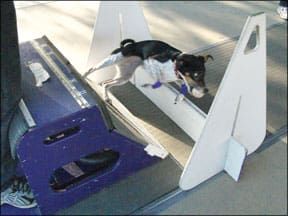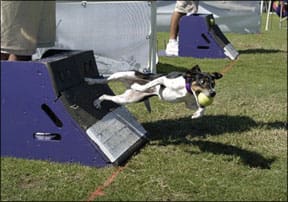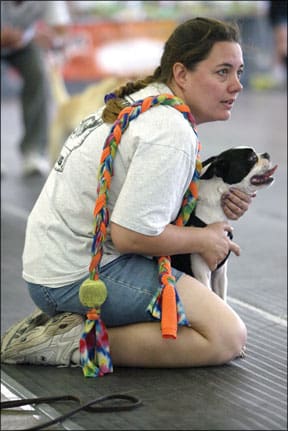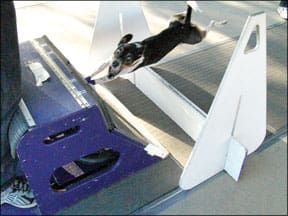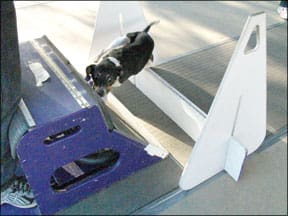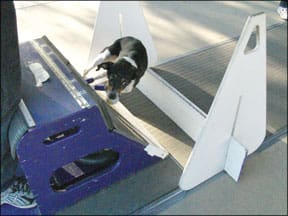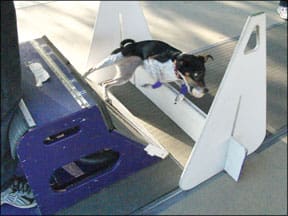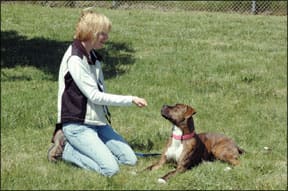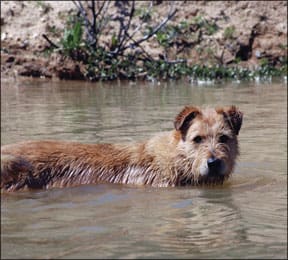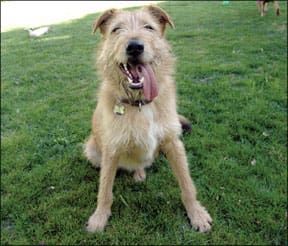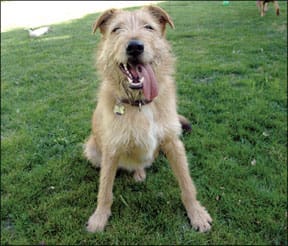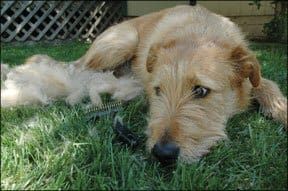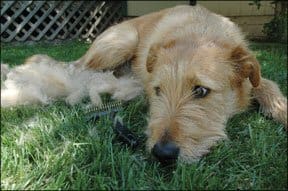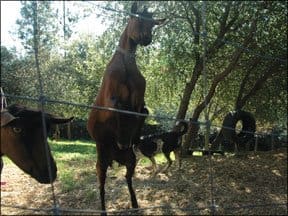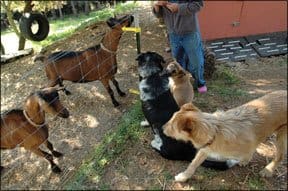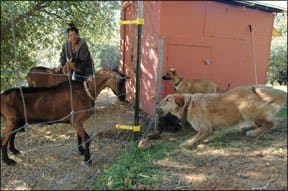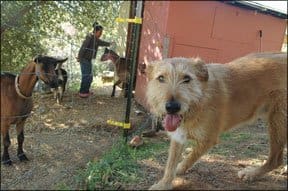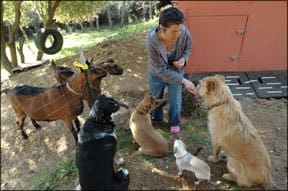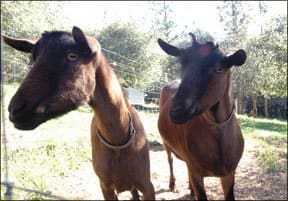[Updated February 6, 2019]
What is this sport? Dock jumping, or dock diving, requires a dog to run with speed to the end of a dock and jump into a pool constructed specifically for the sport. Dogs earn titles based on the distance they cover once they leave the dock.
Prior training required? Sit-stay, love of water, and an obsession about a toy.
Physical demands? On the dog: High. On the handler: Mild.
Best-suited structure? Physically fit dogs of any size.
Best-suited temperament? Confident, high energy.
Cost? High (if you compete regularly).
Training complexity? Low.
Mental stimulation? High.
Physical stimulation? High.
Recreational opportunities? Low.
Competition opportunities and venues? Many in some states, very few or none in others.
Barking dogs, speakers announcing the dog on the dock and who’s on deck, handlers pleading with their dogs to Stay, stay, stay, okay, go get it! SPLASH! The audience cheers, oohs, aaahs, and claps wildly in support of a sport that brings a smile to the face of anyone watching or listening.
Dock Diving Competitions for Dogs
There are a few different types of dock jumping competitions, with new ones being invented all the time. In most events, some aspect of a dog’s leap off a dock into the water is measured, with the highest or longest jump winning the class.
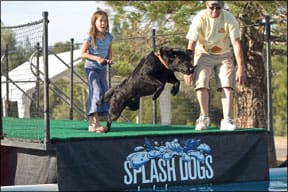
Photo by howie george
Long jumps and high jumps both start with dog and handler climbing a short stairway to reach the top of a dock measuring about 8 feet by 40 feet (there is some variation to dock sizes). The handler brings a toy, which has been selected based on A) the dog’s obsession with it, and B) the ease and predictability with which it can be thrown beyond the edge of the dock into the pool.
For standard dock jumping (which measures forward distance), the handler leaves the dog at the far end of the dock and walks to the end closest to the pool. She then releases the dog and throws the toy into the pool as far as she can, in order to motivate the dog to leap far into the pool to reach the toy. The current record is 28 feet, 10 inches.
The other common type of dock jumping focuses on the dog’s vertical distance. Depending upon the organization putting on the event, this game might be called Extreme Vertical, Super Vertical, or Ultimate Vertical. In this event, an apparatus that suspends the toy is raised over the pool, and the dog leaps vertically to grab the toy before falling into the water with his prize. The current record is 7 feet, 11 inches.
Organizations continue to add classes in the never-ending search for a variation on the theme of jumping into a pool.
The History of Dock Diving
The sport of dock diving or dock jumping got its start in England in the 1970s. In 1997, the United States saw the sport for the first time at the Purina Incredible Dog Challenge. The sport gained in popularity when ESPN televised it as part of their newly created Great Outdoor Games program. Three companies began offering the sport to the general public between 2002 and 2005 primarily through other organizations such as pet expos, hunting and fishing conventions, and other dog sporting venues.
Each of these organizations now offers separate titling opportunities and public demonstrations throughout the country. Two of them, Splash Dogs and Ultimate Air Dogs, also offer titles available through the United Kennel Club.
Many people see dock jumping for the first time while watching TV or at one of those outdoor events. Some of them are hooked the moment they see it.
Linda Hettich of Arcadia, California, was one of those people. “I first saw ‘Big Air’ on ESPN’s Great Outdoor Games in the 2000. It was the craziest sport, dogs running down a dock and flying into a pool. I told my husband, Randy, ‘Hey, our dog can do that!’ It was the perfect sport for him! Kadin (pronounced kuh-DEEN) loved the water, loved swimming and running, and had a very strong toy drive. I looked on the Internet and, unfortunately, there was nothing even remotely close to Southern California.”
It wasn’t until 2005 that Linda and Kadin got their chance, but she and her husband Randy have been training and competing ever since.
Kadin: A Great Last Year
Kadin was Linda Hettich’s first dog to try the sport of dock jumping. His first try at age seven was in early 2005 where he took 1st place in Novice. Hettich believes dock jumping contributed to Kadin’s quality of life as he underwent treatment for cancer.
“Kadin competed in Dock-Dogs at Long Beach and Del Mar (California). Then he com-peted in Splash Dogs in Orange County, where he made the finals for the first time. Then, Kadin was diagnosed with prostate cancer. Randy and I decided to take him to as many events as he could physically handle. It was what he loved to do more than anything.
“He earned his DockDogs Senior Title with both Randy and me at Cynosports in Scottsdale, Arizona. It was there that he jumped his personal best, 18 feet, 3 inches, while undergoing chemotherapy. His last event was two months later in January 2006 at DockDogs at the Fred Hall Fishing Boat and Tackle Show in San Francisco. He miraculously made the finals, as the 12th seed, and he finished 12th. Somehow, with cancer rapidly spreading throughout his body, he jumped 14 feet. He had just turned eight. We had to say goodbye to him just a few weeks later.”
Tessa: A Dock Jumping Addict
by Linda Hettich
Five months after Kadin passed away, we rescued Tessa. She was two years old, a little Lab, barely 20 inches at the withers — although, when we first got her, she was a very overweight 70 pounds! After we got her slimmed down to 50 pounds, we discovered we had a jumper. We introduced her to a pool and she took to swimming and dock jumping immediately.
Tessa is one of those dogs who would run through a brick wall; her drive is incredible. She starts barking from the moment she sees the dock. And she goes nuts when she sees another dog on the dock. “What are they doing on my dock? GET OFF MY DOCK!”
Tessa barks while waiting in line, and she practically rips my arm off trying to run up the stairs. She runs to the front of the dock and barks when I call her back to the end of the dock, jumping over my head as she tries to grab the bumper that I hold high in the air. She harks and harks! I have to stare her down until she stops barking. She is on edge, barely staying in place, until I get to the front of the dock. I turn and see her body tense up, her eyes wide. When I yell, “GET IT!” she runs at top speed down the dock, a little black blur racing past me, before launching herself in the air and into the water.
Tessa is a natural on the dock, as most Labs are. In DockDogs, Tessa holds a Senior Title, a Masters Title, and is on her way to earning an Elite Title. She also holds a Turbo Title in DockDogs Speed Retrieve and recently won a First Place Cadet in Extreme Vertical, then jumped a personal best 6 feet, 4 inches to move into the Top Gun class. Her personal best is 24 feet, 11 inches.
It seemed unreal when we learned that Tessa had developed a squamous cell carcinoma in her mouth; two dogs with cancer in a row? In a way, it was Kadin — the dog we lost to cancer — who led us to the people who helped us get through this. Because of him, we met our veterinary oncologist, people who have gone through similar experiences and supported us, and people who are devoted to raising awareness and money for canine cancer research. Both of our beloved dogs are why we’re devoted to Chase Away K9 Cancer.
Our vets assured us that Tessa’s chances of beating this cancer were good. We immediately began her treatment with radiation every day, Monday through Friday, for four weeks. Tessa lost weight and developed a urinary tract infection, and on some days she was tired. The radiation caused the fur on her chin to fall out, and the skin blistered. (The fur has since grown back, white.) Two immune system-boosting supplements (Eicosa-Derm and ImmunoSupport) helped quite a bit.
Reaching the one-year mark from the time of her diagnosis was a big milestone. Tessa’s oncologist says she looks fantastic and believes she will be fine.
Which Dogs Make the Best Dock Divers?
What sort of dogs will excel at this sport? “Dogs who are crazy about water and crazy about retrieving,” answers Splash Dogs’ Tony Reed. In addition to the usual complement of retrievers, he has seen everything from Pit Bulls to Chinese Cresteds to Dobermans.
This sport attracts a variety of breeds, but understandably is predominated by Labradors. The DockDogs’ website states that 56 percent are Labs. Golden Retrievers constitute 6 percent of the participants, 4 percent are Chesapeake Bay Retrievers; that means that 66 percent are sporting breeds. This makes sense, given that those breeds should love both water and retrieving.
Hettich’s Kadin exemplified this profile. “Kadin was seven years old when he started. He was a German Shepherd/yellow Lab-mix of about 60 pounds. His name means ‘friend’ or ‘companion’ in Arabic. He was very intelligent and highly trainable. He was also a fast runner, a great swimmer, and an incredible jumper. We’d play Frisbee with him and he could catch it in the air, making these incredibly acrobatic leaps. People would always stop to watch him at the dog park.’
Dock jumping requires quick bursts of speed, leaping into the air, and landing in water. Dogs who are physically fit will have fewer injuries than those who are couch potatoes, but as with many of the physically strenuous dog sports, there is always some risk of injury.
Good Handler Attributes
First, you have to have a high tolerance for wet dogs, dogs who smell like wet dogs, and getting wet-dog residue and spit on yourself. But, if seeing your dog play in the water has always put a big smile on your face, this sport will make you absolutely deliriously happy. All you need to do is learn how to throw that toy with reasonable precision. Or know someone who can.
Hettich remembers, “Kadin’s first jump [at a DockDogs event] was 9 feet, 1 inch. The next day, I was showing my husband Randy how to jump Kadin off the dock, but I threw the Floppy Disc clear out of the pool. Kadin immediately jumped in the water, started swimming, and then tried to jump out of the pool where the Floppy Disc had landed. That was the end of my handling career. Randy took over, and by the time the weekend was over, Kadin had jumped over 12 feet.’
Men and women participate in this sport in nearly equal numbers. DockDogs’ site states that 54 percent are men, 46 percent are women, and 9 percent are between the ages of 7-14. Both DockDogs and Splash Dogs have junior handler programs so the entire family can participate.
Equipment and Supplies for Training Your Dog to Dock Dive
There are not too many things required for dock jumping, but each is important.
The Toy
Ah, the almighty toy. Your dog must be insane about a toy, preferably one that can be thrown with some precision into the pool. Favorites in the sport include all the standard toys for retrievers, including bumpers, balls, and Frisbees.
Hettich reports, “I’ve seen the girl rubber chicken toy in a bikini, the boy rubber chicken in board shorts, and a short wooden stick like a 2×4. The retrieve object must be floatable, not edible, and not alive, or not formerly alive. There is a DockDogs legend that someone once asked if he could throw a raccoon in, and was told that no live animals were allowed. So he said, ‘Well, what if it’s in a cage?’ Uh, no.
A Pool or Lake
If you live near bodies of water, you have it made; otherwise, you’ll need a pool or a friend who has one and who doesn’t mind dog hair in their filters.
Miscellaneous Supplies
Towels, water bowl, and treats. Hettich remembers her first dock jumping event and what she forgot to bring. “Being unfamiliar with DockDogs and dog sports in general, all I brought that day was my dog, a Floppy Disc, a tennis ball, and a leash. I had no water, no water bowl, no towel, no crate, no chair, no food, and to make matters worse, I was wearing long pants. I came home in soaking-wet jeans, with a soaking-wet dog and a first-place blue ribbon!’
Dock Diving Competition Expenses
The biggest expenses are travel and entry fees if you choose to compete over an entire weekend.
Travel and Lodging
Hettich gave this example: “Events are usually Friday through Sunday, so figure $100/night for lodging. Let’s say I have an event in Scottsdale, Arizona: $200 for hotel, $95 for gas for 760 miles round trip, $150 for food/water/beverages: $445 total. Multiply that times the four or five events per year within a 400-mile driving distance.’
Entry Fees
Each dock jumping “wave”(single dive or jump) costs $20. Specialty classes such as Extreme Vertical, Speed Retrieve, etc., may cost $25 to $30 to enter. Pre-registration for classes reduces their cost; onsite registration costs a little more. Hettich typically enters 10-11 classes over a typical weekend.
Dock Jump Training
If your dog doesn’t naturally love water, you’ll need to train him to like it. You can start by having your dog bob for hotdogs in a shallow pool, gradually increasing the depth of the water so that he learns to hold his breath and blow bubbles.
Then, transfer this to the steps of a pool or the edge of the lake. You can carry your dog into the water and feed him yummy treats, only gradually lowering him while you still cradle him, just letting him feel the buoyancy that will keep him afloat.
Once he’s comfortable with that, you can let him swim on his own a very short distance with you nearby to cradle him again. Depending on the dog, this can create a dog who gradually likes water more and more or simply tolerates it.
Your dog must like his toy enough to jump into water to get it. Some dogs are natural retrievers while others must be taught to chase, grab, and return the toy to you. If your dog really, really likes a particular toy, you can use it to increase his motivation to enter the water. However, if your dog doesn’t like toys or water, this is probably not the sport for your dog.
Running and jumping off an elevated surface to chase a toy can help, but be careful due to the added risk of landing the wrong way on a hard surface.
Once your dog has a solid retrieve, you’re ready to transfer the behavior to a pool or lake. In a pool, start by getting your dog on the steps of the pool and tossing the toy a short distance away, gradually throwing farther and farther. Next, try him at the edge of the pool and throw the toy a short distance. Wherever you start, make water fun, throw short distances, build confidence, and then build distance. By the time you have built this foundation, you can add height by building platforms from which your dog jumps into the water.
The biggest challenge for dock jumping addicts is finding a place to practice if they live in an urban area and do not have a pool. As a result, most competitors practice at the events themselves.
“Unfortunately, in Southern California there are no official training facilities and very few venues with docks that allow dogs in the water. We have to do our training during practice time at the events. Some competitors use their own pools or take the dogs to dog-friendly beaches.
“We recently established a SoCal DockDogs club, an affiliate of DockDogs Worldwide, and found a training facility at Lake Henshaw in San Diego County. We have had only one practice session there. We are currently trying to find any lake, stream, pond, river, or body of water where we could get permission to build a dock and train.’
Contact one of the organizations listed on page 9 to find other people in your area for support and practice ideas.
Levels of Competition
Each organization has its rules posted on its website. Each has slightly different classes or divisions and distances or heights to be attained in each class for a variety of colorful titles.
For example, Splash Dogs’ “Dock Jumping”is broken down as follows (and each is split further by size of the dog):
Splash: 0-9’11”
Junior: 10′ to 14′ 11″
Senior: 15′ to 19′ 11″
Pro: 20′ to 22’11”
Extreme: 23′ plus
How to Start Dock Jumping
Go online or call each of the organizations listed on page 9 to find a list of upcoming events. Depending upon where you live, there may be many, few, or none. This is a growing sport; each of the organizations has plans to expand geographically.
When you go to a dock jumping event for the first time, you’ll find the staff and volunteers to be very helpful to newcomers. At some events, they even have a practice pool in addition to the competition dock and pool.
Hettich, a journalist by profession, was delighted when she heard about an event being held near her home. She contacted Mark Stuart, who was putting on the DockDogs event, and asked for an interview. She also mentioned, “And by the way, I have this dog . . .”After the interview, Stuart invited her to bring her dog to the event.
She reports: “After fighting Friday afternoon traffic, Kadin and I got there around 2:45. By 3:30, Kadin was successfully jumping off the dock and into the water; by 4 o’clock, we were competing in our first ‘wave,’ and by 4:45, Mark was presenting us with a blue ribbon for finishing in first place in the Novice Division with a jump of 9 feet, 1 inch.
“By 5 o’clock, I placed a hysterical call to my husband Randy, telling him not only did Kadin jump off the dock, but we won! Randy was suffering from a really bad cold at the time and was probably deathly ill, but I told him we absolutely had to come back the next day because he had to try this. And Kadin? He had this crazed look in his eyes that I’d never seen before. He was hooked and so was I.’
Is Dock Jumping for You?
If your dog loves toys, loves water, and has an owner with car keys who will go to the ends of the country to keep that smile on his face, this sport is for you. You don’t need to compete; this is a sport that welcomes newcomers, whether you come out once a year or a dozen times. And bring the family; they won’t want to miss it!
As usual, have fun, train positively, and revel in the relationship with your dog, not the ribbons on the wall.
Terry Long, CPDT, is a writer, agility instructor, and behavior counselor in Long Beach, California. She is addicted to agility and animal behavior.


